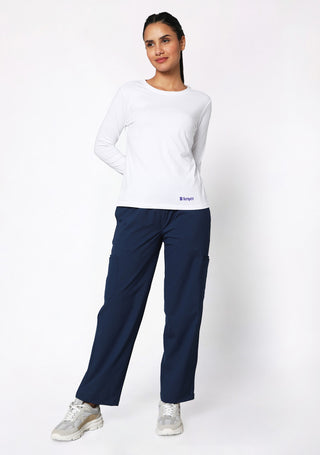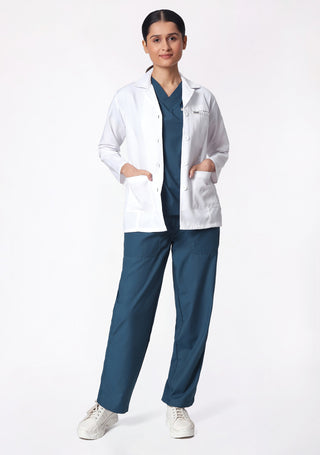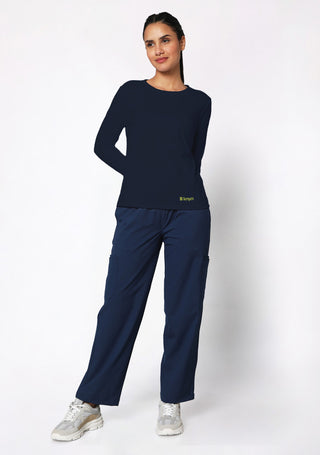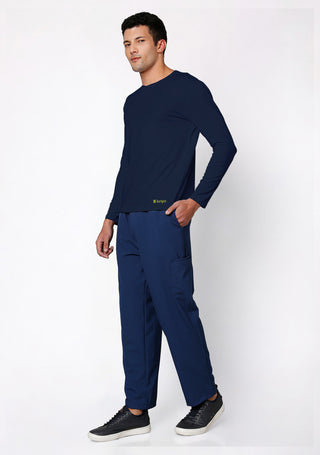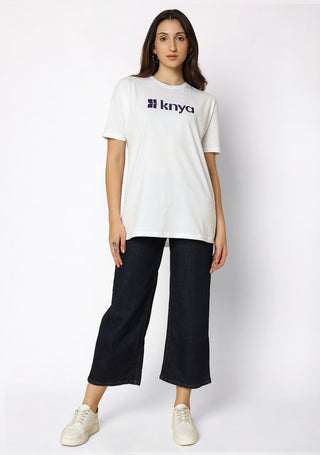Style doesn’t stop at the lab door. With smart color combinations, tailored fits, and just a hint of personality, you can create a wardrobe that reflects not only your professionalism but also your individuality. Mixing and matching scrubs and lab coats is an art one that balances function with flair.Because even in a world of test tubes, charts, and critical care. Looking and feeling great should never be optional.
Why Style Matters in Clinical Settings?
It’s easy to assume that in a field as technical and rigorous as medicine or laboratory science, style would take a backseat. But what you wear plays a subtle yet significant role in how others perceive you and how you feel about yourself.
-
Professionalism: A neat, well-fitting outfit immediately conveys competence and credibility.
-
Confidence Boost: Looking good often translates into feeling good, which enhances communication with colleagues and patients.
- Branding and Identity: For clinics, labs, or hospitals, uniform colors and styles help build identity and unity among the team.
For our male healthcare professionals, we offer a wide range of comfortable and stylish scrubs for men, designed to enhance both comfort and professional image
Build a Coordinated Color Palette
When pairing scrubs with lab coats, color is your best friend (or your worst enemy). A mismatched color combo can look jarring, but a well-coordinated one looks sleek and deliberate.
Classic Neutrals with a Pop
If your scrubs are in bold colors like teal, burgundy, or navy, opt for a white or grey lab coat for contrast. White lab coats are timeless and instantly elevate the look, while grey adds a modern twist.
Wine scrubs with a charcoal grey lab coat = understated elegance.
Monochrome Magic
Going all-in on a single hue can create a clean, streamlined silhouette. Choose lab coats in a slightly lighter or darker tone than your scrubs to avoid a flat look.
Sky blue scrubs with a navy blue lab coat = professional and cool-toned.
Earth Tones and Warm Pairings
Tan, olive, or camel-toned scrubs work beautifully with off-white or khaki lab coats for a softer, nature-inspired aesthetic.
Avoid overly bright color clashes unless it’s part of your workplace’s uniform guidelines.
Fit Is Everything: Tailoring Your Look
Wearing scrubs or a lab coat that’s too baggy or tight doesn’t just affect your look—it affects your functionality and comfort. Prioritize fit as much as fashion.
Scrubs Fit Checklist:
-
Top: Should skim your body, not cling. Choose V-necks for a slimming effect and better movement.
- Bottoms: Straight or tapered leg scrub pants look neater than wide-leg styles. Jogger-style scrub pants are trending and ideal for a more athletic silhouette.
Lab Coat Fit Tips:
- Go for semi-fitted or tailored styles for a more structured appearance.
- Princess seams (in women’s coats) or back belts (in men’s and unisex coats) add subtle shaping.
- Make sure sleeves don’t bunch up or restrict movement—especially if you’re writing, using pipettes, or lifting.
If your lab coat comes with removable belt ties, you can cinch it slightly at the waist for a more defined look without sacrificing comfort.
Fabric and Texture: Comfort Meets Class
All-day wear demands breathable, flexible, and durable fabric. But modern scrubs and lab coats come in a variety of textures and materials that also enhance style.
Scrub Fabric Options:
-
Polyester-Cotton Blends: Durable and wrinkle-resistant.
-
Spandex Blends: Offer stretch and flexibility—great for physically active roles.
- Moisture-Wicking Fabric: Ideal for warm climates or fast-paced environments.
Lab Coat Materials:
-
Twill and Poplin: Crisp, structured look, often stain-resistant.
-
Knit Panels: Increasingly common in lab coats for added stretch at the sides or back.
- Anti-microbial Coats: These don’t just protect you, they stay fresher longer—essential for long shifts.
Look for lab coats with hidden buttons or zip fronts for a cleaner silhouette.
Layer Smartly and Stylishly
Layering is essential, especially in AC-chilled hospitals or variable lab temperatures. But it’s also a way to express your personal style.
Underscrubs:
- Choose fitted long-sleeve tees in neutral or coordinating colors.
- Avoid bulky layers that add unnecessary volume or restrict movement.
Example: A white or light grey fitted underscrub under navy scrubs + white lab coat = layered sophistication.
Jackets and Warm-Up Scrubs:
- Opt for scrub jackets in matching or complementing shades to your scrubs.
- Fleece-lined or knit-cuffed warm-ups are both functional and fashion-forward.
Add Personal Touches—Subtly
Minimalist doesn’t mean boring. Little touches can make your outfit feel more “you” while staying professional.
Name Tags and Badges:
Use clean, high-quality holders or clips. Avoid overly decorative badge reels in formal environments.
Watches and Accessories:
Stick to functional, waterproof watches in simple designs. Avoid dangling earrings or loud bracelets for safety and practicality.
Shoes and Socks:
Your footwear is part of your look! Choose scrub-appropriate sneakers or clogs in neutral or matching tones. Socks can be a space for some subtle fun—think color accents, not cartoon characters.
Click here to Explore All Women's Scrubs and discover our complete collection of comfortable and stylish medical apparel
Styling Ideas for Different Roles
Not all clinical environments are the same. Here are a few curated looks by role:
Medical Student:
Navy blue scrubs + crisp white lab coat + black sneakers
Simple and smart for rounds and practicals.
Lab Technician:
Olive green scrubs + grey lab coat with knit cuffs + utility sneakers
Professional with a functional edge.
Pediatric Nurse:
Teal scrubs + soft white lab coat with colored trim + pastel shoes
Friendly yet polished—perfect for younger patients.
Pharmacist/Clinical Researcher:
Charcoal scrubs + white or light blue lab coat + minimal accessories
Sleek, sharp, and credible in pharmacy counters or presentations.
Maintain Your Look: Cleanliness = Style
Even the best-styled outfit loses impact if it’s wrinkled, stained, or faded. Keep your wardrobe rotation fresh:
-
Iron lab coats and scrubs or use wrinkle-release sprays.
-
Spot-treat stains immediately—especially ink, chemicals, or food.
-
Rotate uniforms regularly to extend longevity and maintain vibrancy.
- Use garment bags for lab coats to prevent yellowing.
Inspiration for the Aspirational
Looking good in scrubs isn’t about vanity—it’s about pride in your profession. When you feel good in your clothes, you walk taller, communicate better, and bring positive energy to your patients and peers. A thoughtful mix-and-match approach to your uniform can remind you every day that you’re not just clocking in—you’re showing up with purpose and presence.
So next time you’re choosing your scrubs and lab coat for the day, take a moment to mix, match, and make it you. You might just find that your uniform becomes your armor—and your statement.





